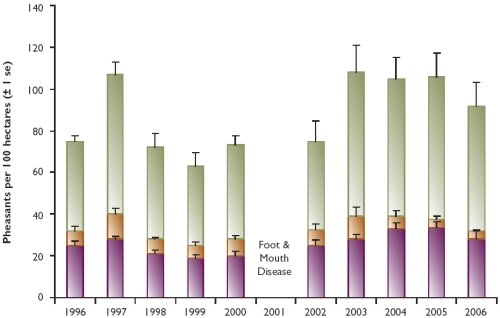Key findings
- Annual harvests of released and wild pheasants have been stable over the last 10 years.
- 2006 was a poor breeding year for pheasants
Monitoring wild pheasants in East Anglia
In 2006 breeding stocks of wild pheasants in East Anglia were 15% lower than in 2005 (see Figure 1). Despite good weather in June and July breeding success was poor across all count sites with below-average productivity (1.3:1 compared with 10-year average of 1.7:1). This resulted in disappointing figures in autumn (37 young per 100 hectares in 2006 compared with 65 young per 100 hectares in 2005). Several of the sites recorded higher than usual mortality in nesting hens in 2006, which probably accounts for the low productivity. The cause of these losses is unclear, but it is likely to be linked to the very cold conditions in May when hens were nesting. Some estates are concerned that disease was important too, although post-mortem examination of sick and healthy birds have so far proved inconclusive. We are encouraging gamekeepers and landowners responsible for managing wild pheasants to submit any sick or freshly dead birds to their vets for post-mortem analysis. This information will help us to determine if there are significant diseases in wild pheasants.
Figure 1: Breeding densities of wild pheasants in East Anglia, 1996-2006
